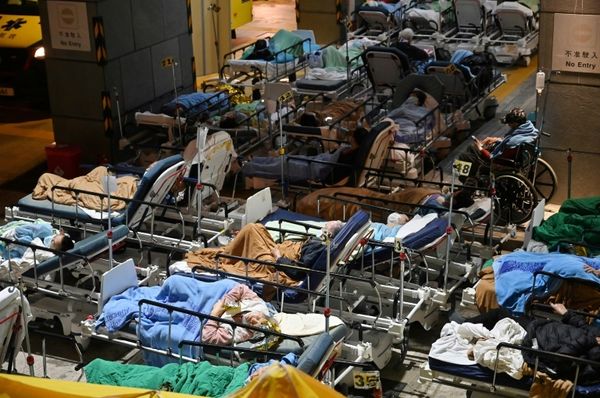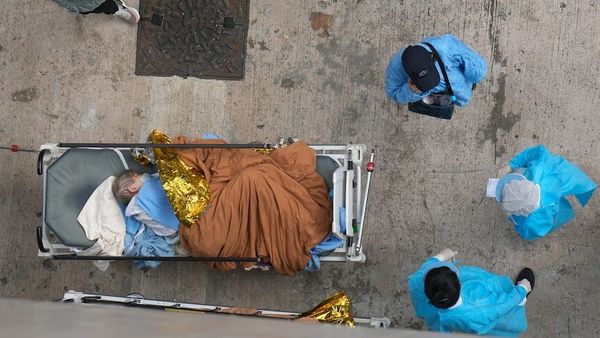HONG KONG — Ting Chan has seen Hong Kong’s pandemic situation lurch from over-the-top caution to outright chaos.
A nurse at one of the city’s public hospitals, she’s been a ground-level participant in the strict COVID Zero strategy that has kept the financial hub largely free of the virus for the past two years. Key to that has been Hong Kong’s mandatory hospitalization of all COVID-19 cases, regardless of whether they are mildly ill or even asymptomatic.
While that’s helped keep the total death toll at a little over 200 for the entire pandemic, those elaborate defenses have collapsed in the face of the highly-transmissible omicron variant.
The city’s current outbreak, with 6,116 cases logged on Thursday, is the worst Hong Kong has seen. But with just 17 COVID patients classed as critical on Wednesday, hospitals are already overwhelmed and the health infrastructure is crumbling.
More than two years since the first Wuhan cases, Hong Kong is seeing the sorts of scenes that marred the early days of the pandemic, when the world knew little about the virus. Elderly patients are lying on gurneys in the street because hospitals have no more space inside and frightened people are flooding emergency rooms. More than 100 COVID-positive people came to Chan’s hospital on a night shift this week, and there were only two nurses to tend to them.
While the vast majority of cases are only mildly ill for now, the pandemic’s history has shown that strain on hospitals has invariably led to a deterioration in medical care and preventable fatalities.
“We never expected things to end up like this,” Chan said.
Neither, it seems, did Hong Kong’s most senior officials.
The shuttered borders and weeks-long traveler quarantines that are the hallmark of China’s COVID Zero approach bought Hong Kong time to prepare, to watch and learn as other world capitals struggled with imploding outbreaks. Yet the government seemed to have no Plan B as omicron cases quickly scaled its hard-core virus controls.
Government advisers and health experts who spoke to Bloomberg News say officials failed to prepare for the virus’s inevitable infiltration by increasing quarantine facilities, isolation wards and hospital capacity during the period of calm over the last year. Though examples of how omicron surges exponentially have been unfolding across the world since last November, Hong Kong seemed to have paid little attention.
Now, faced with no choice but to double down on the zero-tolerance strategy pushed by Beijing, they’re being forced to change policies on the fly and take ad-hoc measures in the middle of a raging outbreak.
A government representative declined to comment beyond officials’ earlier remarks that Hong Kong’s COVID Zero strategy remains the most effective, and that the government is seeking more isolation spaces.
“Omicron changed everything,” Bernard Chan, a financier and convener of Hong Kong leader Carrie Lam’s advisory Executive Council, said in an interview. “The issue is just that it came so fast. The plans were in place, but it just overwhelmed us so quickly.”
Hospitals, which have been told to prioritize children and the elderly, have resorted to setting up rows of tents outdoors to shelter patients while they wait for a bed. Ambulance services are also strained, because some carrying potentially infected people are getting held up at hospitals for hours until there’s space available, according to an emergency room nurse working at a public hospital who asked not to be identified because he’s not authorized to speak about the issue.
The rapidly growing outbreak is only the latest blow to a city once known as a stable place to do business with China. Over the last three years, Hong Kong has struggled with violent anti-government protests, new national security legislation that’s raised questions about the rule of law, and the onerous travel restrictions that have frustrated businesses and contributed to a record exodus of residents.
Tethered to the mainland’s virus strategy, officials are now scrambling to cobble together spare hotel rooms and space in public housing estates to isolate those infected after camps built for that purpose ran out of space. They are requesting mainland officials help ramp up virus testing capacity and build a makeshift hospital.
“I’ve been observing the government’s handling of the pandemic over the past two years — my impression is they have been playing it by ear instead of planning ahead,” said Michael Tien, a pro-China lawmaker in the city’s Legislative Council and a Hong Kong deputy to China’s National People’s Congress. “If the government had planned ahead about what would happen if there’s a huge outbreak, they would have coordinated with the central government on an emergency plan.”
‘Everyone was complacent’
Hong Kong’s daily virus caseloads are still small relative to other global financial cities but part of the danger is that the its elderly population remains dangerously under-vaccinated compared to the rest of the population. Just 40% of those 80 and above are inoculated against COVID.
Public health experts and advisers say Hong Kong officials may have been lulled into believing their measures would continue to be successful, with some tweaks, no matter how the pandemic progressed.
“It’s a failure to recognize the crisis coming in front of us,” said Leung Chi-Chiu, a former chairman of the Hong Kong Medical Association’s advisory committee on communicable diseases. “At a time when we had been able to shut out the virus, everyone was complacent. And that’s the problem. Complacency has a price to pay.”
Leung, as well as other experts, said the government was slow to act even after omicron had clearly seeded in the community before the Chinese New Year holidays, poised for the sort of surging outbreak seen everywhere else. Extended families gathered in large groups over the break and cases took off shortly after.
Throughout the pandemic, Hong Kong has been able to keep both local and imported virus cases close to zero through a mix of strict travel restrictions, contact-tracing and isolation policies.
But as cases rose dramatically, it was clear the city’s existing quarantine capacity of around 5,000 rooms was woefully insufficient to deal with anything more than the tiny virus clusters found locally until omicron.
Once hospitals were overrun there was no longer any way to isolate those testing positive from the wider community — a core component of the COVID Zero approach that is becoming more untenable by the day.
Hong Kong’s hospitals and isolation facilities have “reached a limit” with over 90% of occupancy, health officials said on Wednesday. Thousands who have tested positive are still waiting to be put in isolation, they said.
Chinese President Xi Jinping this week told Hong Kong officials in an unusually direct intervention to take “all necessary measures” to control the outbreak, which political observers interpreted as a frustrated directive to consider harsher measures, including wider lockdowns than the city has so far considered. “The scale and speed of the spread of the virus has overwhelmed our capacity in the fight against the pandemic,” Lam told reporters this week. “The situation is very serious.”
At the moment, epidemiological modeling suggests the outbreak could peak in mid-March, which will mean roughly a month of the Hong Kong’s government struggling to reestablish a “dynamic zero” approach of containing case growth — something some experts think is impossible with omicron’s greater transmissibility.
Meanwhile, Chan, the nurse, and her colleagues are increasingly exhausted from working overtime, she said, as the infected continue to arrive. “We’ve all become disheartened, discouraged.”










